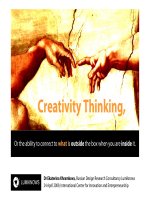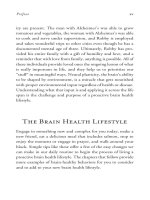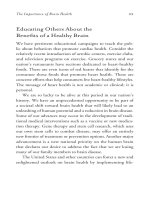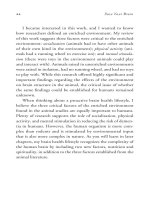Creativity Thinking Or the ability to connect to what is outside the box when you are inside it
Bạn đang xem bản rút gọn của tài liệu. Xem và tải ngay bản đầy đủ của tài liệu tại đây (6.4 MB, 64 trang )
Creativity Thinking,
Or the ability to connect to what is outside the box when you are inside it.
Dr Ekaterina Khramkova, Russian Design Research Consultancy Lumiknows
24 April 2009, International Center for Innovation and Entrepreneurship
Creativity Thinking Today:
1. What is Creativity;
2. Why is it that important for
Innovation Entrepreneurs;
3. Why this is equal to “Design
Thinking”.
© 2009 Russian Design Research Consultancy Lumiknows
2
Abstract painting:
An artistic revolution
of the 20th century.
Kazimir Malevich, Black Square, c. 1915. State Russian Museum, St. Petersburg
© 2009 Russian Design Research Consultancy Lumiknows
3
Art clearly
implied
expression of
ideas
concerning
the spiritual,
Do you know
the
unconscious
and the
how the first abstract
mind.
Fernand Léger,
The Railway Crossing,
1919. The Art Institute
of Chicago
painting was created?
Piet Mondrian,
Composition with Yellow,
Blue, and Red, 1937-42.
Tate Gallery, London.
© 2009 Russian Design Research Consultancy Lumiknows
Jackson Pollock,
Full Fathom Five, 1947.
Museum of Modern
Art, New York City
Catherine de Zegher, Hendel Teicher
(eds.). 3 X Abstraction. NY: The Drawing
Center & /New Haven: Yale University
Press. 2005.
4
Do you know
how the first
abstract painting
was created?
© 2009 Russian Design Research Consultancy Lumiknows
5
Wassily Kandinsky, Composition VII, 1913. The State Tretyakov Museum, Russia
© 2009 Russian Design Research Consultancy Lumiknows
6
One evening in the summer of 1909, Wassily Kandinsky became
aware of the power of abstract art after he saw “indescribable
beauty with an inner glow” in a painting.
“I was startled momentarily, then quickly went up to this
enigmatic painting in which I could see nothing but shapes and
colours and the content of which was incomprehensible to me.”
The answer to the riddle came immediately: it was one of his own
pictures leaning upside down against the wall. But from then on,
Kandinsky was bewitched by the idea that “subject matter was
detrimental to my paintings”.
Pioneer spirit of an artistic revolution, The Times, June 3, 2006
© 2009 Russian Design Research Consultancy Lumiknows
7
The Nine Dot Puzzle
© 2009 Russian Design Research Consultancy Lumiknows
8
The Nine Dot Puzzle
© 2009 Russian Design Research Consultancy Lumiknows
9
The Nine Dot Puzzle
© 2009 Russian Design Research Consultancy Lumiknows
10
Is the point in the “boundary”?
…The puzzle only
seems difficult
because "we
imagine a
boundary around
the edge of the dot
array".
Prof. Daniel Kies
© 2009 Russian Design Research Consultancy Lumiknows
11
/>
The point is in the way of seeing.
© 2009 Russian Design Research Consultancy Lumiknows
12
Western “seeing”: there is a boundary…
Aristotle wrote about Pythagoreans that
for them emptiness serves to divide things
and define their boundaries.
© 2009 Russian Design Research Consultancy Lumiknows
13
Eastern “seeing”: there is no boundary.
Thirty spokes coverage upon a single hub;
It is on the hole in the centre that the use of the cart hinges.
We make a vessel from a lump of clay;
It is the empty space within the vessel that makes it float.
Thus, while the visible has advantages,
It is the invisible that makes it useful.
Lao-Tzu, Tao The Ching, 6th cent. B.C.
© 2009 Russian Design Research Consultancy Lumiknows
14
The concept of the
“Emptiness” (= Nothing)
later turned into
Newtonian Space
as a Container for
things.
© 2009 Russian Design Research Consultancy Lumiknows
15
The concept of the
“Invisible” (= Something)
later transformed
into Einstein’s
Relative Reality.
© 2009 Russian Design Research Consultancy Lumiknows
16
Two different modes of solving problems:
Nothing, Emptiness
Something, Context
• Focus on what is already known;
• “Nothing” behind what is seen;
• Limited possibilities.
• Shift of focus to the “Big Picture”;
• There is “Something” behind it, even
if we don’t see this right now;
• Abundance of possibilities.
© 2009 Russian Design Research Consultancy Lumiknows
17
How does it to do with the
Innovation Entrepreneurship?
Red Oceans are all the industries in
existence today—the known market
space. In the red oceans, industry
boundaries are defined and accepted.
As the market space gets crowded,
prospects for profits and growth are
reduced.
Blue oceans, in contrast, denote all the
industries not in existence today—the
unknown market space. In blue oceans,
competition is irrelevant because the
rules of the game are waiting to be set.
Blue ocean is an analogy to describe the
wider, deeper potential of market space
that is not yet explored.
A conversation with W.Chan Kim and Renee Mauborgne.
INSEAD, 2005.
© 2009 Russian Design Research Consultancy Lumiknows
18
How does it to do with the
Innovation Entrepreneurship?
Red Ocean Strategy
Blue Ocean Strategy
Search for the market instead of in the market is a key to
success in today’s Innovation Economy.
© 2009 Russian Design Research Consultancy Lumiknows
19
How does it to do with the
Innovation Entrepreneurship?
Red Ocean Strategy
Blue Ocean Strategy
From New Product to New Market Development.
© 2009 Russian Design Research Consultancy Lumiknows
20
/>
Assuming that structure and market boundaries exist only in managers’ minds,
practitioners who hold this new view do not let existing market structures limit their
thinking. To them, extra demand is out there, largely untapped.
Kim, Chan, Blue Ocean Strategy.
© 2009 Russian Design Research Consultancy Lumiknows
21
In order to get to the future first, there is no
need to excel competitors trying to get the
same prize because the number of prizes
may be the same as the number of
runners.
G. Hamel & C. K. Prahalad,
Competing For The Future.
© 2009 Russian Design Research Consultancy Lumiknows
22
The crux of the
problem is where
to look for these
prizes...
© 2009 Russian Design Research Consultancy Lumiknows
23
/>
In people’s needs.
© 2009 Russian Design Research Consultancy Lumiknows
24
Where to look for “the prizes”?
Not in narrow defined
customer experience,
© 2009 Russian Design Research Consultancy Lumiknows
25









